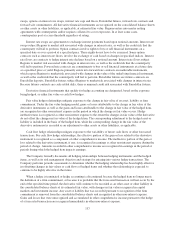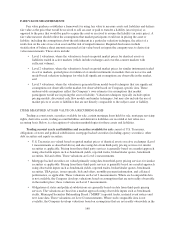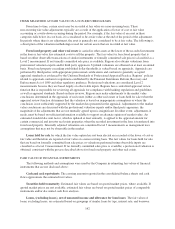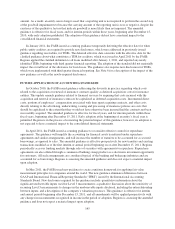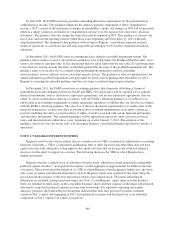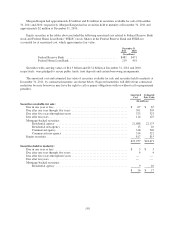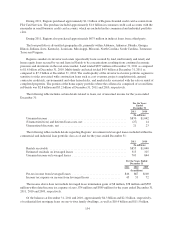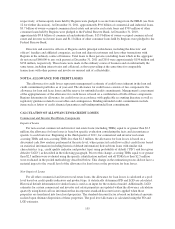Regions Bank 2011 Annual Report Download - page 169
Download and view the complete annual report
Please find page 169 of the 2011 Regions Bank annual report below. You can navigate through the pages in the report by either clicking on the pages listed below, or by using the keyword search tool below to find specific information within the annual report.amount. As a result, an entity can no longer assert that a reporting unit is not required to perform the second step
of the goodwill impairment test because the carrying amount of the reporting unit is zero or negative, despite the
existence of the qualitative factors that indicate goodwill is more likely than not impaired. The amended
guidance is effective for fiscal years, and for interim periods within those years, beginning after December 15,
2010, with early adoption prohibited. The adoption of this guidance did not have a material impact to the
consolidated financial statements.
In January 2011, the FASB issued accounting guidance temporarily deferring the effective date for when
public-entity creditors are required to provide new disclosures, which were addressed in previously issued
guidance regarding receivables, for TDRs. The deferred effective date coincides with the effective date for the
clarified guidance about what constitutes a TDR for creditors, which was issued in April 2011 by the FASB.
Regions applied the clarified definition to all loans modified after January 1, 2011, and reported any newly
identified TDRs beginning with third quarter financial reporting. The adoption of the standard did not materially
impact the overall level of the allowance for loan losses. The guidance also requires new disclosures for TDRs,
which were implemented with third quarter financial reporting. See Note 6 for a description of the impact of the
new guidance as well as the newly-required disclosures.
FUTURE APPLICATION OF ACCOUNTING STANDARDS
In October 2010, the FASB issued guidance addressing the diversity in practice regarding which costs
related to the acquisition or renewal of insurance contracts qualify as deferred acquisition costs for insurance
entities. This update amends guidance related to financial services by requiring that costs incurred with the
acquisition and renewal of insurance contracts be capitalized as deferred acquisition costs. Incremental direct
costs, portions of employees’ compensation associated with time spent acquiring contracts, and other costs
directly relating to the advertising, underwriting, issuing and processing of insurance policies are costs that
should be capitalized to the extent that they would not have otherwise been incurred had the contracts not been
successfully acquired. The amended guidance is effective for fiscal years, and for interim periods within those
fiscal years, beginning after December 15, 2011. Early adoption at the beginning of an entity’s fiscal year is
permitted. Regions is in the process of reviewing the potential impact of this guidance; however, its adoption is
not expected to have a material impact to the consolidated financial statements.
In April 2011, the FASB issued accounting guidance to reconsider effective control for repurchase
agreements. The guidance will simplify the accounting for financial assets transferred under repurchase
agreements and similar arrangements, and will increase the number of transfers to be accounted for as secured
borrowings, as opposed to sales. The amended guidance is effective prospectively for new transfers and existing
transactions modified as of the first interim or annual period beginning on or after December 15, 2011. Regions
periodically accesses funding markets through sales of securities with agreements to repurchase. Repurchase
agreements are also offered through a commercial banking sweep product as a short-term investment opportunity
for customers. All such arrangements are considered typical of the banking and brokerage industries and are
accounted for as borrowings. Regions is assessing the amended guidance and does not expect a material impact
upon adoption.
In May 2011, the FASB issued new guidance to create a uniform framework for applying fair value
measurement principles for companies around the world. The new guidance eliminates differences between
GAAP and International Financial Reporting Standards (“IFRS”) issued by the International Accounting
Standards Board. New disclosures required by the guidance include: quantitative information about the
significant unobservable inputs used for Level 3 measurements; a qualitative discussion about the sensitivity of
recurring Level 3 measurements to changes in the unobservable inputs disclosed, including the interrelationship
between inputs; and a description of the company’s valuation processes. This guidance is effective for interim
and annual periods beginning after December 15, 2011, and all amendments will be applied prospectively with
any changes in measurements recognized in income in the period of adoption. Regions is assessing the amended
guidance and does not expect a material impact upon adoption.
145




